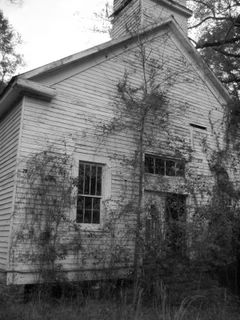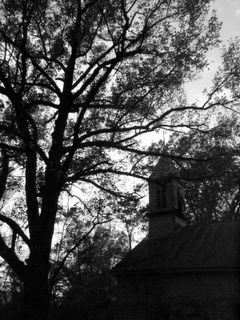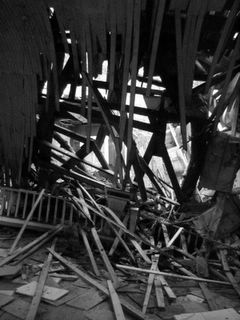Holy Places

Today while our school quiz bowl team was driving back from a competition on the Coast, our conversation turned to ghost stories and such, which can be great fun, particularly on dark rainy days. But while we traded stories of 'haunted' locales, a thought occured to me: here in the South, and throughout the US, there are numerous 'haunted' places, locations with dark shadows and stories of evil and murder and senseless violence and all that. But there are no holy places (or comparatively few), at least not as a Catholic or Orthodox- or once Catholic or Orthodox- nation would know them. There are no holy wells, no villages 'haunted' by a Saint, few places with marvelous benevolent memory of some holy man, at least not of the caliber of our evilly haunted and storied places. This, in opposition to the 'Old World' where there are haunted castles and holy wells; kelpie-inhabited lochs and holy islands.
The main sites that I can think of as being particularly hallowed here in the South are churches, cemeteries, and battlefields. The later I grew up regarding with great reverence, and for good reason: it was on the fields of Shiloh, Vicksburg, Chickamaugua, Atlanta, right down to Bentonville, that my own ancestors and their countrymen fought and died. And the places where the Army of Northern Virginia trod were- are- downright shrines, where the soil itself reminds you of the steps of Lee and Jackson and the men who followed them. We not quite have a King Afled or St. Edmund, but we do have General Jackson and General Lee. We may not keep relics of saints, but we have kept the relics of our saintly heroes (and yes, I have seen General Jackson's horse, Old Sorrel, stuffed and displayed at VMI).
Beyond that, there is little 'sacred geography' in the South in the sense of sites associated with Saints or our Lady or the like. But we do have, alongside our battlefields, churches and cemeteries: small churches pervade the rural South, and there are few places like an old cemetery cloistered deep inside the woods. These are, I suppose, the main and true content of Southern sacred geography. When I was little, living in rural (very rural!) Alabama, my parents would take me to old cemeteries, where we would look at the old tombstones and try to imagine the people whose bodies lied buried beneath. (Yes, there wasn't much in the way of recreation or excitment around there!) I still have a tendency to stop at cemeteries and look. The most poignant are often African-American cemeteries, often unfenced and grown up, the tombstones simple affairs, frequently homemade from cement and hand-enscribed in a wandering script. But the saddest sights are the numerous tiny blocks of stone that barely peek above the grass or leaf mould. These almost always mark infants' grave-sites, engraved with only initials. Or those tombstones, also so frequent, whose birth and death dates are but a handful of years apart.
And churches- old churches really, wood-frame sort that surprise you on country roads- always have a hallowed feel. The pictures are of one of my favorites. It's on Old Port Gibson Road, thirty or forty miles east of the Mississippi River, above Natchez. I don't know what its name was or denomination or anything. It's just there, sitting off the road behind privet and sweetgum. A little cemetery lies up the hill from it, and a ten-foot deep sunken road drops down through the woods nearby. The new road lies a good ways off. I missed it the first time I went by. When I finally saw it, I managed to stop and visit one evening, with the sun setting behind the sweet gum and oak. The front is still holding up, but the back has caved in, the victim of a tree-fall. The timbers crashed down upon the pulpit. It's starkly evocative. Haunting, but in the holy way. I would not expect ghosts there, or malignant spirits. Saints, maybe.

But we have few places- I cannot really think of any rural ones- that have a relation to a particular saint, in any way. We may have houses haunted by unquiet dead and other imports from Europe and Africa, but it seems that the holy men and women who hallowed wells and built monasteries had worse luck on the voyage over. I am glad for what we do have, but there is a feeling that there is something missing. Our sacred geography is incomplete. It is beautiful and bound into the landscape and our lives, but I would that it were deeper and yet richer. And, like that church on Old Port Gibson Road, all too much is in a state of decay. But that is a story for another time.













1 Comments:
You're the second person to comment on my blog with the same nom de plume. The other Manalive is in Quebec. I really appreciate your meditative, well-illustrated blog. My favorite holy place was my granmother's kitchen table. I used to set across from her and describe the birds at the feeder to her after her eyes became cloudy from cataracts.
S.A.
Post a Comment
<< Home